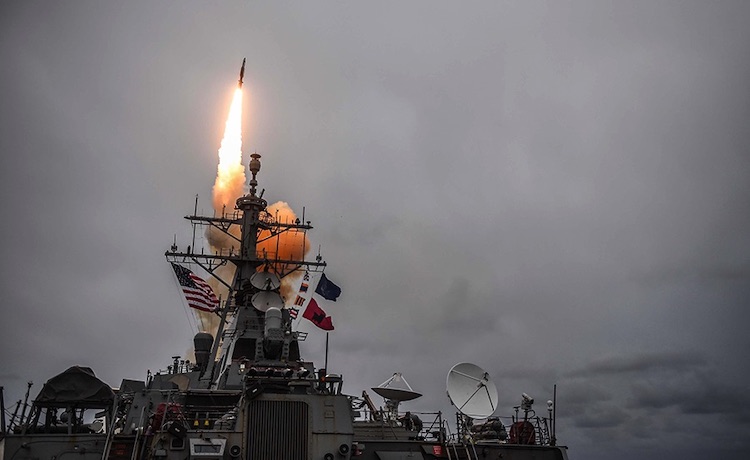By J C Suresh

TORONTO | WASHINGTON (IDN) – President Trump’s legacy is far from inspiring. Joe Biden and his team face numerous crucial decisions. Arms policy experts believe that one of the momentous decisions confronting the new administration is “whether and how to move forward with Trump-era plans to expand the U.S. national missile defence footprint with new sea-based missiles that can shoot down long-range ballistic missiles”. But this will undoubtedly hamper progress on arms control. [2020-12-04 | 20] ARABIC | GERMAN | JAPANESE TEXT VERSION PDF
Nuclear strategists have long understood that developing and deploying strategic missile interceptors to target nuclear-armed adversaries is ineffective, but they could still induce them to develop an arsenal of new, more powerful missile systems to overcome and bypass missile defence, says Daryl G. Kimball, Executive Director of the Arms Control Association.
A new interceptor, known as the Aegis Standard Missile-3 (SM-3) Block IIA, which was successfully tested on November 16, could help defuse the North Korean ballistic missile threat in the short term. But it will certainly encourage Russia and China to believe that they need to further improve their nuclear arsenals in response to the United States missile attacks, say knowledgeable sources.
To prevent costly and destabilizing missile competition, Washington and Moscow had agreed to limit the number of strategic missile interceptors to no more than 100, as provided for in the 1972 ABM Treaty. This ceiling allows a limited number of interceptors to be deployed in the event of an attack by a nuclear-armed adversary.
Since the U.S. withdrawal from the ABM Treaty in 2002, Washington policymakers have focused on improving capabilities to counter limited missile threats from “rogue” states. But the Pentagon has deployed only 44 strategic interceptors as part of its ground-based medium-range defence system.
On the one hand, North Korea has improved its ballistic missile capabilities in recent years, on the other the U.S. Congress has poured billions more into the Missile Defence Agency to develop, acquire, test, and research new technologies. In 2019, the Trump administration’s Missile Defence Review recommended strengthening the U.S. homeland’s defence capabilities to defend it against “rogue” state threats.
President Donald Trump said: “The goal is to ensure that the United States can track and destroy any missile fired from anywhere, anytime.” The system would be capable of intercepting land-based intercontinental ballistic missiles (ICBMs), as well as sea, intercontinental and surface-to-air missiles.
The Pentagon’s current plans call for a total of 1,000 of the new missile defence systems to be built and deployed worldwide by 2030, both on land and at sea.
Nearly $180 million is earmarked to improve the system’s ability to intercept ICBMs and intercept surface-to-air missile threats. If adopted, this approach would be a significant step forward in defence against North Korea, Russia, China, Iran, and other rogue states and their ballistic missiles.
Against this backdrop, Kimball is of the view that as a first step, the Joe Biden administration should reiterate that U.S. missile defence capabilities at home are able to defend against the threat of third-party offensives, not against more sophisticated Russian and Chinese capabilities.
“Such a clarification alone will not be sufficient,” writes Kimball. Moscow, he adds, has conditioned further offensive nuclear cuts on future limits on U.S. missile defences. Russia claims its efforts to develop new intercontinental-range nuclear delivery systems such as an undersea torpedo, hypersonic glide vehicle, and nuclear-powered cruise missile are designed to overcome U.S. missile defences.
China has already begun to respond to U.S. missile defence capabilities by diversifying its nuclear strike capabilities, including by increasing the number of silo-based ICBMs that are armed with multiple warheads.
He warns that U.S. efforts to further limit Russian nuclear weapons and bring China into the arms control process are unlikely to gather momentum unless Washington agrees to seriously discuss its long-range missile defence capabilities, including the SM-3 Block IIA. “Fielding sufficient missile defences to defend against limited ballistic attacks from North Korea or Iran and agreeing to binding limits on the quantity, location, and capability of such defences should not be mutually exclusive.”
But doing so will require the Biden administration to move away from the simplistic notion that there should never be any limits on U.S. missile defences.
Twenty years ago, then-Senator Biden argued for the “development of a theater missile defence that enhances regional stability” and against a strategic missile defence system that “would be seen as threatening by both Russia and China”. Now, as President, he is responsible for adapting the U.S. missile defence strategy so that it strikes the right balance. [IDN-InDepthNews – 04 December 2020]
Photo: The U.S. Navy Arleigh Burke-class guided-missile destroyer USS Donald Cook (DDG 75) fires a Standard Missile-3 during exercise Formidable Shield 2017 over the Atlantic Ocean, Oct. 15, 2017. Credit: U.S. Navy.






